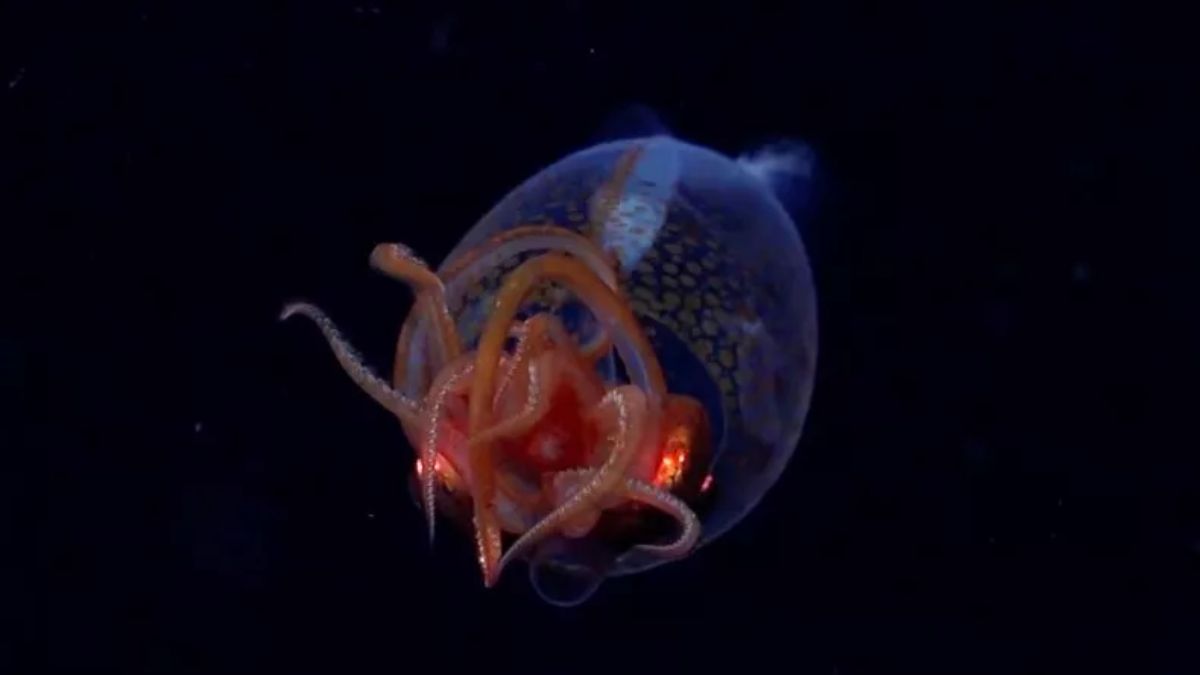The colossal squid has long been one of the ocean’s most mysterious creatures—rarely seen, rarely caught, and never filmed alive.
That changed recently when marine scientists and crew aboard the research vessel Falkor recorded the first-ever video of a colossal squid gliding through its natural habitat. Captured thousands of feet below the surface of the South Atlantic Ocean, the footage marks a historic moment, coming nearly a hundred years after the species was first identified.
Here’s what we know so far about this deep-sea creature.
The colossal squid (Mesonychoteuthis hamiltoni) is one of the largest and most elusive invertebrates on Earth.
Found in the icy depths of the Southern Ocean near Antarctica, this soft-bodied marine animal is somewhat like an octopus, but with a much bulkier frame and far greater length.
Experts estimate that colossal squids can reach lengths of up to 7 metres (around 23 feet) and weigh as much as 500 kilograms.
When they’re young, these creatures are almost see-through, giving them the glassy, ghost-like look that’s typical of many deep-sea juveniles. As they grow, their appearance changes drastically, taking on a deep red or purplish colour and developing thick, muscular arms.
What really sets the colossal squid apart, though, are the sharp, swivelling hooks on its tentacles, something no other squid species has. It’s also known for having the largest eyes of any animal ever discovered, believed to help it detect prey and predators in the pitch-black ocean depths.
For decades, our only glimpses of these creatures came from carcasses inside the stomachs of sperm whales or from dying specimens accidentally hauled up by deep-sea fishing trawlers. The very first discovery of a colossal squid happened back in 1925, but until now, no one had ever caught one alive on camera. But why?
Dr Kat Bolstad, an associate professor at the Auckland University of Technology, who helped identify the colossal squid, explained to NPR that due to their large, sensitive eyes, they usually choose to avoid research equipment that can be bright and loud. Sometimes, squids may react to threats by holding as still as possible, hoping to go unnoticed.
According to the Natural History Museum, it is difficult to estimate the global population of colossal squids.
In 2022, the institution said the absence of observations meant that “even to this day, the enormous invertebrates still straddle the line between legend and reality”.
Also read: None has ever been seen alive: Has the ‘world’s rarest whale’ washed up on a beach in New Zealand?
How was the colossal squid spotted?
The colossal squid was spotted during an ambitious deep-sea expedition led by a team from California’s Schmidt Ocean Institute. The scientists spent 35 days exploring the remote waters in search of undiscovered marine life, and in March, their efforts paid off in a big way.
The discovery happened near the South Sandwich Islands, at a depth of about 600 metres, where the team was operating a remotely controlled underwater vehicle. It was there that they captured the world’s first-ever footage of a juvenile colossal squid swimming in its natural environment.
Dr Michelle Taylor, the expedition’s chief scientist, told the BBC that the team wasn’t entirely sure what they were looking at at first—but they decided to record it anyway because it looked “beautiful and unusual.”
The creature in the footage measured around 30 centimetres and was later confirmed to be a juvenile colossal squid by marine biologist Kat Bolstad. “It’s exciting to see the first in situ footage of a juvenile colossal and humbling to think that they have no idea that humans exist,” she said.
Earlier this year, during a previous expedition aboard the Falkor, a team of scientists also filmed a glacial glass squid (Galiteuthis glacialis) alive in the wild for the first time. Like the colossal squid, this species had never been observed in its natural habitat before.
“The first sighting of two different squids on back-to-back expeditions is remarkable and shows how little we have seen of the magnificent inhabitants of the southern ocean,” Dr Jyotika Virmani, Schmidt Ocean Institute’s executive director, told the BBC. “These unforgettable moments continue to remind us that the ocean is brimming with mysteries yet to be solved.”
With input from agencies


)
)
)
)
)
)
)
)
)